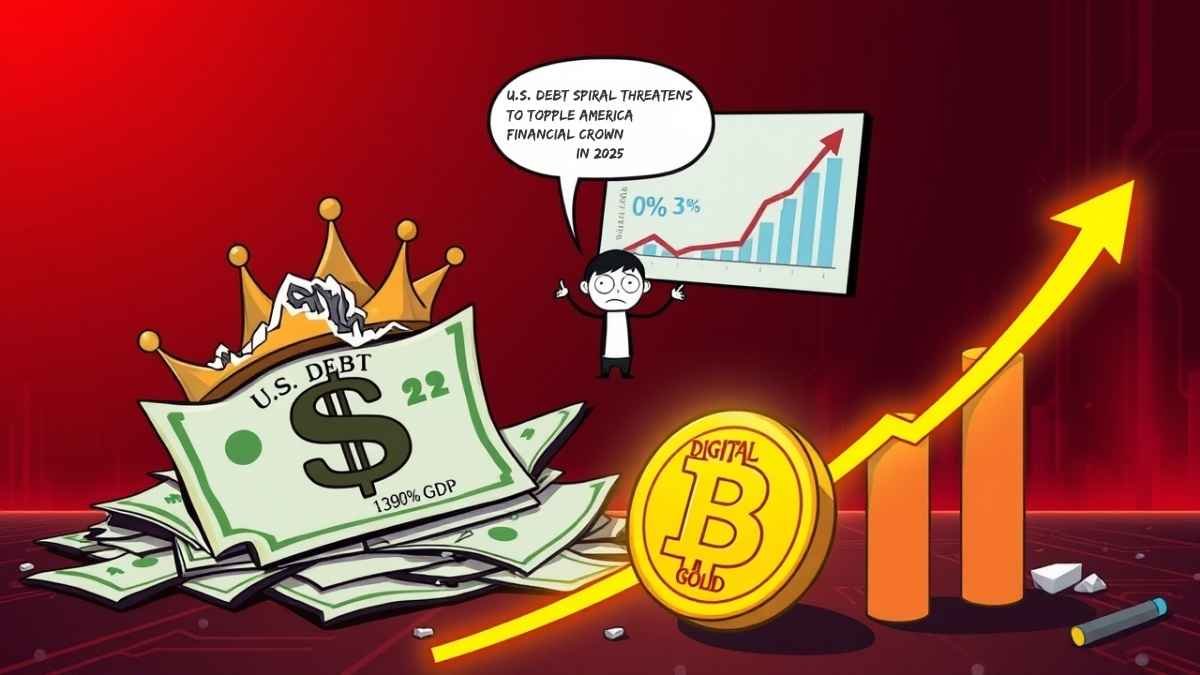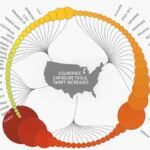Riding at the top position due to the world currency status of the dollar provides “exorbitant privilege” to American leadership. A Moody’s report issued on March 25th 2025, delivers a serious cautionary message about the rising debt levels, which warns of potential dollar crown loss. Can the U.S.’s uncertain AAA credit rating and financial turmoil bring transformations to markets and changes in crypto’s position throughout 2025? Let’s unpack the stakes.
The Universal Credit Research Authority (Moody’s) Warns About the United States Losing Its Global Financial Supremacy Through Debt
Moody’s isn’t mincing words. The world’s top credit rating of the U.S. depends mainly on its position as the global reserve currency and its role as central to international financial operations. The superpowers which gave the United States its dominance are starting to collapse because of excessive debt accumulation. The combination of Federal Reserve rate increases and Biden administration deficit spending created an upward pressure on the financial costs of borrowing. And Trump’s plans? According to Moody, tariffs, unfunded tax cuts, and economic risks will further increase the nation’s problems.
- U.S. interest payment amounts will devour 30% of national revenue by 2035, starting from a 9% share in 2021.
- The United States faces a debt scenario where the ratio between national debt and GDP is expected to grow to 130% by 2035, starting at 100% this year.
According to the Congressional Budget Office, the United States will experience coronavirus debt growth to 214% of GDP by 2054 when Trump’s 2017 tax cuts remain in force. The cost of borrowing will escalate to 250% if borrowing costs increase by just 1%. Moody’s asserts signs are pointing towards a rating downgrade for the United States because of its November 2023 negative outlook on the country.
The Privilege Under Siege
The world’s allegiance to Treasuries alongside the dollar has allowed America to obtain debt at low interest rates. But Moody’s warns it’s fraying. The Trump administration recommends structural reform through deregulation and enhanced energy production to increase taxable income and reduce inflation, which will guide the Federal Reserve in decreasing interest rates. According to the report, there is no indication of a sudden economic recovery. Under the best possible economic circumstances, U.S. debt remains less affordable than AAA nations Germany and Canada.
Chief economist Bruce Kasman from JPMorgan expressed to Fortune on March 24 that America maintains an impressive position supported by its liquid markets, a rule-based governance system, and dominant economic strength. According to him, foreigners maintain a strong interest in purchasing U.S. assets. The assessment includes restrictions: An uncontrolled deficit situation or unclear revenue sources may damage investor interest. According to his predictions, the U.S. debt will experience a gradual rise in interest costs between 50 and 100 basis points.
How It’s Played Out Before
Moody’s stands among numerous organizations with concerns about the American fiscal situation. Fitch decided to downgrade the U.S. rating in 2023 because of worsening fiscal conditions and chaotic debt-ceiling situations. The credit rating agency S&P took similar ratings action following the fiscal deadlock in 2011. The recent rise in American interest payments and evolving policies pursued by Trump have caused Moody’s analysts to identify reduced differences between financial strength and fiscal insanity within the United States. Neither the White House nor X gave any statement regarding this situation, as X chatter was divided into two factions, which celebrated Trump’s economic expansion moves versus those who feared future debt implications.
The crypto market takes advantage of dollar volatility to fetch digital currency gains.
The marijuana meets its climax for crypto enthusiasts in this segment. Alternative currencies might gain popularity if U.S. investors lose confidence in debt issuances and the dollar-issued currency. The “digital gold” appeal of Bitcoin finds its strongest grounds when fiat currencies experience difficulties, such as global financial distress in 2020. Stretching Treasury bonds might encourage investors to consider decentralized assets based on rising borrowing expenses and prolonged inflation. Social media users frequently argue that Bitcoin replaces the declining dollar on the X platform. Hyperbole? Maybe. But 2025 could test it.
This isn’t a cliff-edge crisis—yet. According to Kasman’s theory, slow material changes require an extended period of time that spans months instead of days. The creditworthiness of the USA remains affected by the projected 130% debt-to-GDP ratio for 2035, despite the possibility of an earlier market disturbance due to a negative review from Moody’s. The future of crypto adoption depends on numerous unpredictable factors, which can benefit from a weakening dollar or upset the market through worldwide chaos. America’s privileged position has lost its invincibility, so the nation is displaying signs of weakness.








